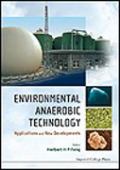
Environmental anaerobic technology: applications and new developments
Fang, Herbert H.P.
Anaerobic technology has become widely accepted by the environmental industryas a cost-effective alternative to the conventional aerobic process. In addition, with the intrinsic advantages of energy saving, reduced sludge yield, andproduction of biofuel, anaerobic process will be the favored green treatment technology for sustainable environment in years to come. Written by 40 renowned experts from 13 countries/regions, this book consists of 18 chapters compiling state-of-the-art information on new developments in various aspects of anaerobic technology. These include development of new types of reactors, uses of molecular techniques for microbial studies and mathematical modeling, productions of bio-hydrogen by fermentation and microbial electrolysis cell, as well as broadening applications to the treatment of municipal wastewater, effluents from chemical industry and agricultural wastes with high lignocellulose content. INDICE: Overview and Outlook: The Route of Anaerobic Waste (Water) Treatment Toward Global Acceptance (G Lettinga); Full-Scale Applications: Developments of New Anaerobic Treatment Technology in France (R Moletta); Applications and New Developments of Biogas Technology in Japan (Y-Y Li & T Kobayashi); Anaerobic Sewage Treatment Using UASB Reactors: Engineering and Operational Aspects(J B Van Lier et al.); Application of UASB Technology for Sewage Treatment with a Novel Post-Treatment Process (S Uemura & H Harada); Emerging Technologies: Anaerobic Granulation and Granular Sludge Reactor Systems (J H Tay et al.); Anaerobic Membrane Reactors (D C Stuckey); The Anaerobic Baffled Reactor (ABR)for Wastewater Treatment (D C Stuckey); Anaerobic Treatment of Phenolic Wastewaters (D Liang & H H P Fang); Application of Molecular Methods for Anaerobic Technology (T Zhang); Application of Mathematical Models to Anaerobic Digestion Process (H Yasui & R Goel); New Developments: Anaerobic Digestion of Lignocellulosic Wastes by Rumen Microorganisms: Chemical and Kinetic Analyses (Z-H Huet al.); Enzymatic Treatment of Lignocellulosic Wastes for Anaerobic Digestion and Bioenergy Production (G D Saratale et al.); Biohydrogen Production by Fermentation and Microbial Electrolysis Cells (N Q Ren et al.); Research and Development of Biohydrogen Production in Taiwan (C-Y Lin & C-H Lay); A Two-Stage Fermentation Process Converting Waste and Wastewater to Hydrogen and Methane (H-S Shin & D-H Kim); Bio-Productions of Hydrogen and Ethanol from Sugarcane (AReungsang & P Plangklang); Synthesis Gas Fermentation (S Sung & P-H Lee).
- ISBN: 978-1-84816-542-7
- Editorial: Imperial College
- Encuadernacion: Cartoné
- Páginas: 404
- Fecha Publicación: 01/12/2010
- Nº Volúmenes: 1
- Idioma: Inglés
